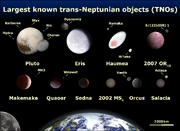
Comparison of Pluto, Eris, Haumea, 2007 OR10, Makemake, Quaosar, Sedna, 2002 MS4, Orcus, Salcia, and Earth, along with the Moon
A trans-Neptunian object (TNO) is any minor planet in the Solar System that orbits at a greater distance than the planet Neptune, the most distant planet from the Sun, which has a semi-major axis of 30.1 astronomical units (AU).
Typically, TNOs are further divided into the classical and resonant objects of the Kuiper belt, the scattered disc and detached objects with the sednoids being the most distant ones. As of October 2018, the catalog of minor planets contains 528 numbered and more than 2,000 unnumbered TNOs.
The first trans-Neptunian object discovered was Pluto in 1930. It took until 1992 to discover a second trans-Neptunian object orbiting the sun directly, 15760 Albion. The most massive TNO is Eris, followed by Pluto, 2007 OR10, Makemake and Haumea. More than 80 satellites have been discovered in orbit of trans-Neptunian objects. TNOs vary in color and are either grey-blue (BB) or very red (RR). They are thought to be composed of mixtures of rock, amorphous carbon and volatile ices such as water and methane, coated with tholins and other organic compounds.